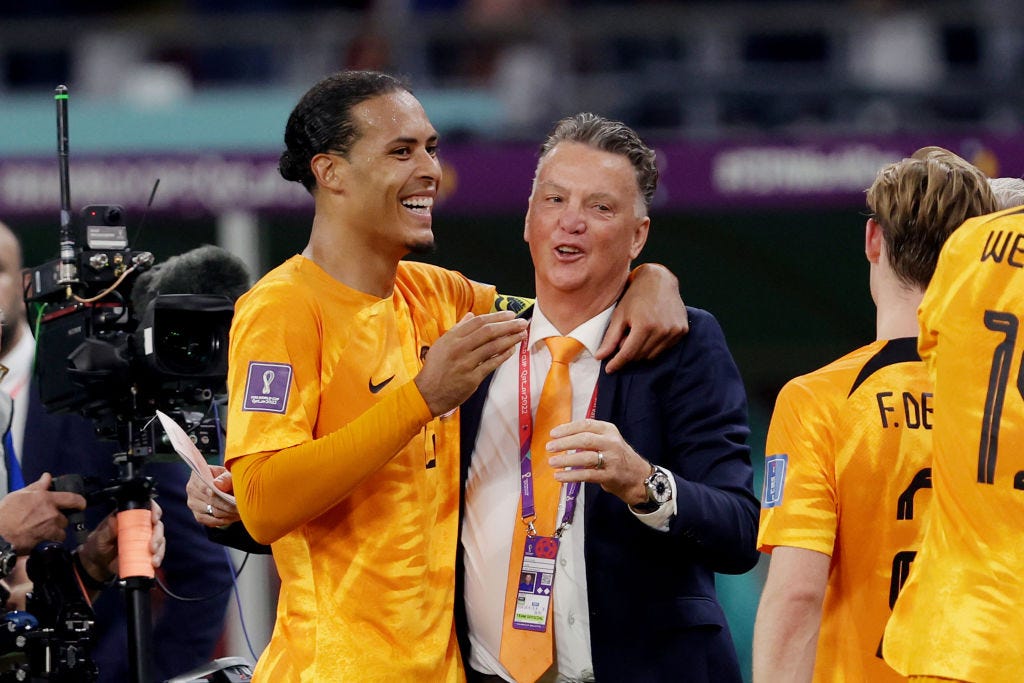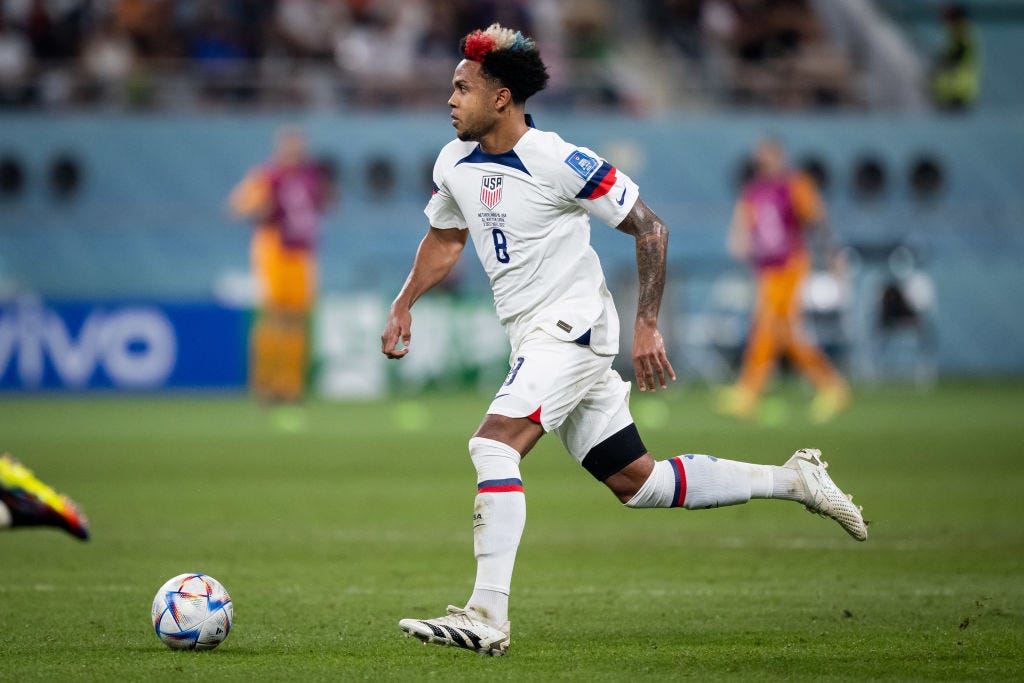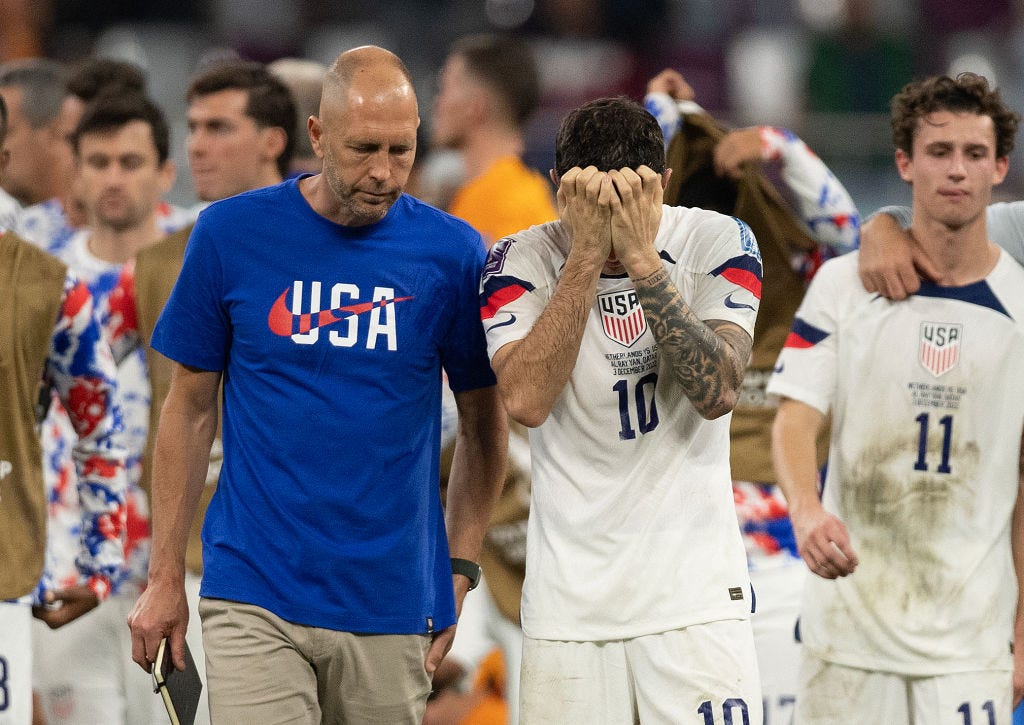Premium: This U.S. World Cup is Over, but 2026 Awaits
The USMNT got punished by the Netherlands in a 3-1 loss, and the aftermath mixed regrets over missed opportunities and excitement for World Cup 2026 at home.

AL-RAYYAN, Qatar — Last Saturday, on a small spit of sand and land in the Persian Gulf, one U.S. World Cup campaign ended just as another one began. The U.S. lost 3-1 to the Netherlands in the Round of 16 in a game that became a Rohrshach test of sorts.
What do you see here? That the Dutch scored three times in similar circumstances, with all three scorers going unmarked in the box and two goals coming from eerily similar cutback passes by right wingback Denzel (Yes, I’m Named for the Actor) Dumfries? Or do you see that the U.S. had more shots on goal (8 to 6) and possession (58% to 42%) in a game where expected goals were basically even (1.9 for the Netherlands to 1.7 for the U.S.)?
GrantWahl.com is reader-supported. Free and paid subscriptions are available. This is how I make a living, and quality journalism and traveling to Qatar require resources. The best way to support me and my work is by taking out a paid subscription now.
Ultimately, this game was decided by what did and didn’t happen in the scoring zones. In the third minute, U.S. winger Christian Pulisic took a pass from Tyler Adams in what appeared initially to be an offside position but wasn’t. Pulisic’s shot was saved by goalkeeper Andries Noppert, a huge moment that prevented the U.S. from securing something tangible from its early possession advantage.
“It hurts,” Pulisic said afterward. “I thought I was way offside when it happened, but I still hit it. And he made a good save.”
For its part, the Netherlands scored on its first real attacking play of the game, with Memphis Depay finishing a gorgeous 20-pass sequence in which he wasn’t tracked by Tyler Adams and Yunus Musah and took advantage of it.
“It came down to both boxes,” U.S. goalkeeper Matt Turner said. “We say it’s the basics. We had great buildup. We had great pressing. But at the end of the day they finished their chances in the box, and we didn’t.”
The U.S. possession advantage was striking. When I did television work with former Dutch coach Guus Hiddink during the 2018 World Cup, I remember him being upset with France coach Didier Deschamps even after Dechamps’ team had beaten Croatia 4-2 in the final. For Hiddink, who values attacking play above all else, it was embarrassing that Deschamps had turned a French team with so much talent into a counterattacking outfit. Winning the trophy wasn’t enough to placate Hiddink.

And so I can imagine that he wasn’t thrilled with the way Dutch coach Louis van Gaal approached the U.S. game, even if his team won. The Netherlands ceded possession to the U.S., backed up its line of confrontation, deployed a man-to-man defense in the midfield and forced the U.S. centerbacks to pick out passes in the start of the attack.
It mostly worked. The Dutch struck on the counter, with Dumfries bombing down the right side and leaving cutback passes into the box for Memphis (in the 10th minute) and Daley Blind (on nearly the last play of the first half). Memphis, at 28, still has a lethal combination of speed, smarts and experience, but Blind, at 32, is old as the hills. That they were both able to go unmarked in the U.S. penalty area was stunning.
“Normally, we’d have someone on the cutback space,” said U.S. left back Antonee Robinson. “Very similar goals. They just found someone there, and they’ve got quality players who can finish their chances.”
“Holland had a clear game plan,” Turner said. “Every time they got into those wide crossing positions, they didn’t cross the ball early. Typically teams have done that to try to get the ball in front of our goal inside our six. And Tim [Ream] and Walker [Zimmerman] are really great at clearing and dealing with those. It was like [the Dutch] had a little bit of extra patience and cut the ball back, and we didn’t track runners well all night.”
The defensive lapses were uncharacteristic for a U.S. outfit that had been the only World Cup team of 32 not to concede a goal in the run of play during the group stage. But those mistakes made the difference at a stage of the World Cup when the winning margins become extremely small.
“In the past three games, I’d say we defended the moments really well,” said Adams, who was probably the U.S.’s best player at this World Cup. “And today the three goals come from moments where we’re probably sleeping a little bit. So we have to look at it.”
For his part, Adams said he wasn’t surprised the U.S. had a possession advantage against the Dutch. “I would say our team probably sets up really well for a man-against-man,” he said. “Even in the midfield, whenever me, Weston and Yunus came down to get the ball, dribbling out of spaces and stuff like that, athletically I would say that we probably had a little bit of an advantage in there. But that being said, I think we probably could have used that man-against-man to our advantage a little bit more, maybe with some more deep runs, pulling them out of position even more and moving the ball a little bit quicker.”
It’s probably worthwhile to have a discussion on what the word dominant means in soccer these days. Just as he did after a 2-0 loss at Canada in January, U.S. coach Gregg Berhalter used the word to describe the opening stages of the Netherlands game. “We started the game extremely well,” he said, “dominant in every aspect of the game.”
Yet dominant shouldn’t reflect a mere possession advantage (especially when the Dutch were ceding possession) but rather a chance-creation advantage, and just as in that Canada game, the U.S. had more possession against the Netherlands without putting together appreciably more scoring opportunities.
The second Dutch goal right on the brink of halftime was an absolute killer. Instead of going into the locker room feeling that it was completely in the game, the Americans took a gut punch that was preventable, a blow that put the U.S. in desperation mode after 45 minutes.
“That was brutal,” Turner said. “To give up that extra goal, it was off a throw-in. I mean, there’s no real excuse for it. Everything that could have gone wrong on that play did.”
“We were down 2-0,” said Pulisic, “but it didn't feel like it should be that way.”
Berhalter inserted the forgotten attacker Gio Reyna for centerforward Jesús Ferreira to start the second half and later moved Reyna out wide to bring on Haji Wright up top. Chances came for the Americans. In the 49th minute, Ream had a shot cleared off the line in a scramble. Wright took too heavy a touch in the 75th minute to ruin one great chance, but he somehow (inadvertently?) redirected a Pulisic cross into the net in the 76th to make the score 2-1.
The closest the U.S. got to equalizing was in the 78th minute, when Noppert barely won a footrace with Wright to a spot outside the penalty area and cleared a piercing through-ball away from danger. Dumfries put the game away three minutes later with another unmarked finish in the U.S. box. “I’m too focused on Gakpo being in the box alone,” said Robinson, “and [Dumfries] is behind me.”
Said Berhalter afterward: “They won the game 3-1, and they achieved what they wanted to do, which is go to the next round. And that’s in the end the most important thing. What I’d say is they were clinical in the opportunities that they got in the first half. And other than that, I think there wasn’t a ton separating the two teams.”
Make no mistake, the U.S. players weren’t content to just reach the Round of 16. They wanted to win the World Cup. Pulisic looked and sounded emotionally shattered after the game. His voice was even quieter than usual. He knows you don’t get many chances at a World Cup in your career, even when you have a young team.
“It’s another experience for all these guys, and there’s moments that we can be proud of,” Pulisic said. “But we don’t want to feel like this again. We want to put ourselves in a position to win tournaments like this.”
And that brings us to the 2026 World Cup, set to take place in the United States, Mexico and Canada. There has been a tendency all along to look at this 2022 World Cup as the chance for a wildly young U.S. outfit to gain experience that will set it up for a deep run at home four years from now.
That makes sense, but in speaking to the players here, even the youngest ones acknowledged that they may not make the team in ’26, that they wanted to go on a deep run now and believed it was possible. The World Cup is a young man’s tournament. Just ask over-the-hill Belgium.
What was this young U.S. group missing here? A dangerous center-forward, for one. You have to hope that the U.S. can discover such a player in the next four years. Maybe that’s Ricardo Pepi. Maybe it’s someone else entirely.
“We have a very young group,” Berhalter said. “ We have players that are beginning their careers. But we don’t have a Memphis Depay right now, who's scoring in Champions League and playing in Barcelona, who’s been an international for years and years.”

The USMNT’s objective this cycle was a straightforward one after the crushing failure to qualify for the 2018 World Cup. “We had a common goal four years ago,” said McKennie “a mission that we set out on, which was to change the way the world views American soccer. I think this tournament has really restored a lot of belief, restored a lot of respect to U.S. Soccer and to soccer in our country. I think we’ve shown that we can beat giants eventually. We may not be there yet, but I think we are definitely on our way.”
The next World Cup may be three-and-a-half years away, but it is at home, and the chances of the sport and the U.S. team taking a leap forward are there.
“It just shows the potential,” Zimmerman said. “It shows what we’ve been talking about—the growth of the American player, how dynamic this team can be, the individuals that we have that create an exciting brand of soccer to watch. And so I think this World Cup showed that attacking talent, showed that fight. And I think something that a lot of American fans can look at and be proud of the way that we played, the way that we went about our work. So I think we'll be back hungrier than ever.
“[In 2026] a lot of guys in there will be in what you’d consider their prime,” Zimmerman went on. “And we have a lot of guys coming through the pipeline that I think can contribute moving forward. So it’s an exciting time to be an American soccer fan. We talked a lot about leaving a legacy. And that’s what hurts. We felt like this was a group that could have done something that no American team had done before.”
Will Berhalter be the coach the next cycle? That remains to be seen. He hasn’t specifically stated that he wants to keep the job, and much will depend on his boss, U.S. Soccer sporting director Earnie Stewart, and the preferences of the USSF hierarchy.
“Regarding me personally, for the last month and a half I’ve just been only focused on the World Cup, only focused on achieving things with this group,” Berhalter said after the game. “And in the next couple weeks, I’ll clear my head, I’ll sit down and I’ll think about what's next.”
The youth of this U.S. team is exciting, of course, but as it approaches the next World Cup the U.S. shouldn’t leave out the possibility that an older player might suddenly find the form of his life. That’s what happened with Ream in this World Cup. The 35-year-old was recalled to the national team after a year away and was one of the U.S.’s top players of the tournament.

Ream acknowledged to me in a one-on-one interview before the game that his performances at Fulham and for the U.S. recently are the best he has played in his career. At 35. That’s something to remember for 2026—not necessarily to include Ream, who will be 38, but perhaps someone else on the older side of 30.
“I don’t know that I necessarily can tell you exactly why,” Ream said of his late-career rise this season. “But I think I’m feeling as good as I ever have physically and mentally. I’m seeing things better than I ever have, recognizing patterns of play and recognizing things that are going to happen before they actually happen. I know that I’m 35 years old. This isn’t going to last forever. And why not enjoy every last ounce that I possibly can? That’s allowed me to just go and play the game like I was a little kid again.”
Age is a number, and you don’t need to be 20 to feel like a kid on a World Cup field. In 2026, it will be refreshing in some ways not to talk about how young this U.S. team is anymore. It will be go time—and a measure of progress that the expectations for the U.S. will be a run to the quarterfinals or beyond.





Time to hold the complexity. The US was at a talent deficit and had some serious lapses on defense. But I think it's huge that the expected goals were so even-- and remember, the US would have had an advantage until that third goal when they were stretched and trying to equalize.
This team will probably be better in every phase of the game at the next one. And they will have had another 3.5 years to practice, playing together, and figure out what works best for the talent available. I'm beyond excited for it!
Thanks so much, Grant, for adding so much to this cycle!
Unless we get some
Brilliant young players ( like an MBappe) or some of our current team members blossom, having the WC in North America will have no impact. This team cannot finish, is indecisive ( often we dribble or pass our way out of quality shots), and regards set pieces as an annoyance. I watch some of the shots taken from well outside the box today by France and Poland ( rockets on frame ) and think of our outside shots ( either easy, dribbling ground balls or twenty stories over the frame). We do not have finishers. We won’t get any better just by the passage of time. We need better talent. I think you are being far too kind . But I am frustrated